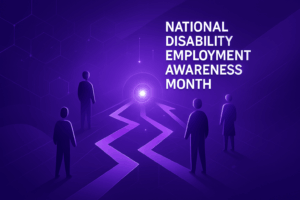Image generated with ChatGPT (GPT-5) by OpenAI
Concept and prompt developed by Alliance Enterprises
Celebrating Value and Talent: Honoring National Disability Employment Awareness Month
October is National Disability Employment Awareness Month (NDEAM) in the United States. I am not sure there has ever been a more critical time in history to highlight the importance of this month. Although significant civil rights gains have been made in the 80 years since we first began celebrating this observance, current national trends risk eroding many of these achievements—particularly in the arena of employment. This year’s theme, “Celebrating Value and Talent,” reminds us of the tremendous opportunity employers have to find skilled, dedicated employees within the disability community.
A Brief History of NDEAM
Congress first established “National Employ the Handicapped Week” in 1945, a recognition of veterans with disabilities returning from World War II. In 1988, the observance was expanded to a full month and renamed “National Disability Employment Awareness Month” to better reflect the diverse community of people with disabilities. Each year, the Office of Disability Employment Policy (ODEP) within the U.S. Department of Labor leads the celebration, setting the annual theme and providing tools and resources to promote inclusion and opportunity.
A Vast and Untapped Workforce
People with disabilities make up nearly one-quarter of the American population—a significant community of qualified workers who can contribute to the success of local businesses and strengthen communities. Building inclusive workplaces not only benefits individuals with disabilities; it contributes to the overall vitality and innovation of business itself.
But inclusion doesn’t happen by accident. It requires thoughtful strategy—intentional efforts to recruit, hire, and support people with disabilities as valued employees. It also requires that employers and human resource professionals understand workplace accommodations and assistive technology—tools that don’t just help employees with disabilities, but often improve overall productivity and efficiency. The Job Accommodation Network (JAN) reports that most accommodations cost little or nothing to implement and yield substantial benefits in employee retention and morale.
A Personal Reflection
As a young rehabilitation counselor in the early 1980s, I placed my first person in a job in rural western Nebraska. At the time, I was unfamiliar with Section 504 of the Rehabilitation Act. The Americans with Disabilities Act had not yet been passed, and I was unaware of National Disability Employment Month. I was simply working with adults with schizophrenia who told me they wanted to work.
I didn’t realize that competitive employment wasn’t considered typical for many of the individuals in my program. So, I just started knocking on doors—talking to local employers, looking for opportunities, and trying to create ways for these individuals to succeed on the job. At first, I appealed to employers’ sense of altruism—doing the right thing. But I quickly learned that goodwill alone could only take us so far. Long-term success came when employing a person with a disability made good business sense.
That lesson has stayed with me throughout my career. The same principle applies today: inclusive hiring must work for both the employee and the employer. When it does, everyone benefits.
Why Hiring People with Disabilities Makes Good Business Sense
Data consistently shows that employees with disabilities perform at the same level as their peers without disabilities. Where they often excel is in loyalty and longevity—they tend to stay with their employers longer and demonstrate exceptional commitment. Yet despite these strengths, unemployment and underemployment among people with disabilities remain stubbornly high.
NDEAM shines a light on this untapped potential, encouraging employers to see inclusion not as charity, but as smart business strategy. Neither the ADA nor the Rehabilitation Act can force employers to hire people with disabilities. Those laws remove barriers; they do not create opportunity. The real change happens when employers recognize that people with disabilities bring value, talent, and perspective to their organizations.
Building Partnerships for Inclusion
Many employers remain uncertain about accommodations and assistive technology—often overestimating costs or not knowing where to begin. This is where state vocational rehabilitation (VR) agencies and community rehabilitation programs (CRPs) play a vital role. They are experts in workplace accommodation, assistive technology, and disability inclusion.
Vocational rehabilitation counselors can partner directly with businesses to help them recruit qualified candidates and implement accommodations that work. These professionals understand the ADA, the Rehabilitation Act, and the nuances of inclusive employment.
Several national organizations also serve as valuable partners to employers, including:
- State Developmental Disabilities Agencies
- Association of People Supporting Employment First (APSE)
- Job Accommodation Network (JAN)
- Disability:IN (formerly the National Business Leadership Network)
At the national level, the Council of State Administrators of Vocational Rehabilitation (CSAVR) provides leadership through its National Employment Team (The NET)—a coordinated effort that connects employers with qualified candidates through state VR agencies across the country. CSAVR serves as both an advocate and a partner in advancing employment opportunities for people with disabilities.
Looking Ahead
As we face reductions in federal programs and resources, the partnerships among employers, state vocational rehabilitation agencies, and community organizations become even more critical. These networks of support can help employers find qualified candidates, implement accommodations, and build inclusive workplace cultures that drive success.
NDEAM is more than a month of recognition—it is a call to action. Employers have the opportunity to celebrate value and talent every day by opening doors to an underutilized but immensely capable segment of our workforce.
When we invest in inclusion, we invest in innovation, loyalty, and community strength. That’s not just good ethics—it’s good business.
Summary
Each October, National Disability Employment Awareness Month reminds us of the vital contributions of workers with disabilities and the ongoing need for inclusive employment practices. This year’s theme, “Celebrating Value and Talent,” underscores how people with disabilities strengthen our businesses and communities—not through charity, but through ability, skill, and dedication.
This blog was edited with the assistance of ChatGPT
Resources considered in the development of the blog inlcude:
National Disability Employment Awareness Month (NDEAM) | U.S. Department of Labor
Job Accommodation Network Low Cost, High Impact



